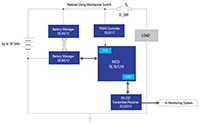 Renesas’ winning combination battery management systems (BMS) can be comprised of many functional blocks, including cutoff FETs, a fuel gauge monitor, cell voltage monitor, cell voltage balance, real-time clock (RTC), temperature monitors, and a state machine.
Renesas’ winning combination battery management systems (BMS) can be comprised of many functional blocks, including cutoff FETs, a fuel gauge monitor, cell voltage monitor, cell voltage balance, real-time clock (RTC), temperature monitors, and a state machine.
There are many types of battery management ICs available. The grouping of the functional blocks varies widely from a simple analog front-end that offers balancing and monitoring and requires a microcontroller (MCU) to a standalone, highly integrated solution that runs autonomously.
This reference design utilizes an ISL94212 Li-ion battery manager IC, which supervises up to 12 series of connected cells. The device provides accurate monitoring and three cell balancing modes – manual balancing mode, timed balancing, and auto balance mode with extensive system diagnostics functions. The BMS IC communicates to a host MCU via an SPI and to other BMS IC devices using a robust, proprietary, two-wire daisy chain system.
Features
- Highly integrated MCU
- Supports both standalone and daisy-chained configurations
- GUI provided export option for generation of detailed register and/or SPI communications log files
- RL78/G14 MCUs
- Low-power: as low as 66 µA/MHz and 0.60 µA for RTC + LVD
- 1.6 V to 5.5 V operation
- 16 KB to 512 KB Flash
- 44 DMIPS at 32 MHz
- ISL94212 Li-ion Battery Manager ICs
- Supervises up to 12 series-connected cells
- Provides accurate monitoring, cell balancing, and extensive system diagnostics functions
- ISL8117 Synchronous Buck Controllers
- Generates POL voltage rails and bias voltage for a wide variety of applications in industrial and general-purpose segments
- 4.5 V to 60 V wide input voltage
- 0.6 V to 54 V wide output voltage
- ICL3221E RS-232 Transmitters/Receivers
- 3.0 V to 5.5 V powered
- Provides ±15 kV ESD protection (IEC61000-4-2 air gap and human body model) on RS-232 pins
- Meets EIA/TIA-232 and V.28/V.24 specifications, even at VCC: 3.0 V
 Renesas’ winning combination battery management systems (BMS) can be comprised of many functional blocks, including cutoff FETs, a fuel gauge monitor, cell voltage monitor, cell voltage balance, real-time clock (RTC), temperature monitors, and a state machine.
Renesas’ winning combination battery management systems (BMS) can be comprised of many functional blocks, including cutoff FETs, a fuel gauge monitor, cell voltage monitor, cell voltage balance, real-time clock (RTC), temperature monitors, and a state machine.





























